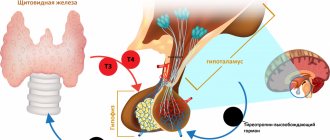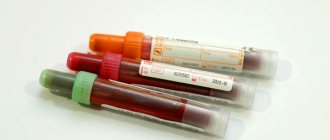Scientific editor: M. Merkusheva, PSPbSMU named after. acad. Pavlova, medical practice. March, 2021
Synonyms: PSA total, prostate-specific antigen total, Prostate-specific antigen total, PSA total.
Prostate specific antigen (PSA) is secreted by the epithelial tissues of the prostate gland. Its purpose is to naturally liquefy sperm. Therefore, normally, PSA is always present in the blood of a healthy man, but its concentration should not go beyond the established normal values. Otherwise, we can talk about the development of pathological changes in the structure and functioning of the prostate.
A test for total PSA in plasma is the most reliable and indicative in the diagnosis of benign and malignant prostate diseases and other pathological changes (inflammatory processes, infection, proliferation of pathogens, etc.). The main purpose of the study is to diagnose oncology.
General information
Prostate specific antigen is a glycated protein, a small part of which, after production by the prostate gland, is released into the bloodstream, where it circulates in 2 states - free and bound. The combination of both of these fractions is the total PSA. Their ratio is approximately 9:1. With prostate carcinoma (cancer), the level of the bound form in the blood increases, which leads to a decrease in the ratio between free and total PSA.
An increase in the level of antigen in plasma is observed in the presence of benign or malignant diseases, inflammatory and infectious processes, mechanical and thermal injuries, as well as after certain therapeutic and diagnostic procedures. A temporary release of the component is caused by ejaculation, after which its level stabilizes again after 2 days.
With age, the concentration of total PSA increases, and the percentage of the free fraction, on the contrary, decreases. A PSA test is recommended annually for men over 50 years of age (age risk group). Early screening (before 40 years of age) is indicated for patients with a burdened medical history (malignant processes in first-line relatives).
Interpretation of test results is always carried out simultaneously with other diagnostic studies: analysis of biological fluids, rectal palpation of the prostate, MRI, biopsy, ultrasound, radiography, etc.
PSA is able to inhibit the migration, proliferation and invasion of endothelial cells in the tumor and, accordingly, slow down its growth. This function may partly explain the naturally slow progression of prostate cancer.
Why is this informative?
The medical definition of PSA indicates that normally the bulk of this protein substance is located in the ducts of the gland. Its task is to provide the desired consistency of the seminal fluid and promote its liquefaction. In healthy men, a small portion of the protein passes from the ductal system into the blood vessels and then into the blood. It is this parameter that is monitored during screening.
An increase in the indicator occurs in response to certain changes in the body. With the development of pathology, the barrier between the blood vessels and the ducts of the gland is broken, which causes massive penetration of protein into the blood.
Indications
The main purpose of determining total PSA in plasma is screening for prostate cancer (PCa), including as an additional marker based on the results of a rectal examination.
The study is also carried out to determine the stage of the cancer process, the likelihood of relapse or remission, metastasis, general prognosis, which is important in the first 6-18 months of treatment, and making a decision on whether to perform a prostate biopsy. The test allows you to monitor the effectiveness of the chosen treatment regimen (chemo-, drug or radiotherapy, hormone replacement therapy, physical therapy, surgery, etc.).
In what cases is analysis prescribed:
- Suspicion of benign or malignant processes, inflammation of the prostate, structural changes in its tissues;
- Age over 50 years (mandatory screening);
- Age over 40 years (if there are close relatives with pelvic cancer);
- Prostatic hyperplasia;
- The patient complains of difficult, painful and frequent urination;
- An increase in the size, consistency and structure of the prostate gland according to rectal examination or ultrasound.
The interpretation of the analysis results is carried out by an oncologist, surgeon, urologist, and therapist.
Reviews from men about PSA testing
Men are frightened by even a slight excess of the norm, and this is quite natural. Below are questions regarding the interpretation of the results and answers from doctors.
From the forum https://sprosivracha.com/questions/185256-povyshen-psa:
From the forum https://www.oncoforum.ru/forum/showthread.php?t=108654:
From the forum https://www.oncoforum.ru/forum/showthread.php?t=56704:
Normal total PSA values
Important! Standards may vary depending on the reagents and equipment used in each particular laboratory.
That is why, when interpreting the results, it is necessary to use the standards adopted in the laboratory where the analysis was carried out. You also need to pay attention to the units of measurement. For a long time it was believed that total PSA should be in the range from 0 to 4 ng/ml. But according to medical statistics of recent decades, a malignant process can begin and progress at lower PSA levels (up to 2.5 ng/ml).
The current normal values for the total PSA test are presented in the table:
| Age, years | Total PSA norm, ng/ml |
| 40-49 | 0-2.5 |
| 50-59 | 0-3.5 |
| 60-69 | 0-4.5 |
| 70-79 | 0-6.5 |
A general PSA test is always combined with the determination of its free form. The latter is distinguished by the fact that it does not bind to other proteins and circulates in its original form (as it was produced by prostate epithelial cells).
As a rule, all circulating forms of PSA are determined in one analysis sample, after which their mathematical ratio is established as a percentage. This information is especially necessary in a situation where total PSA reaches 10 ng/ml, which may be due to an increased risk of severe inflammatory processes in the prostate and the appearance of malignant neoplasms. When the ratio of free to total PSA is more than 25%, the oncologist diagnoses non-malignant pathologies, while a ratio of less than 15% is an additional marker for determining cancer.
To assess pathological risks, namely, when the PSA threshold of 4 ng/ml is exceeded, the ratio (index) of the required indicators is calculated using the formula:
free PSA / total PSA * 100%
A result of more than 25% indicates a benign process or a favorable prognosis for various inflammatory diseases, structural changes in the prostate, etc. Values up to 10% indicate a high risk of developing oncology.
Important! The interpretation of the results is always carried out comprehensively.
It is impossible to make an accurate diagnosis based on only one analysis.
Types of PSA blood tests
The PSA marker in the blood is found in two forms:
- free - not associated with other proteins;
- bound - connected to the protein alpha-antichymotrypsin.
The sum of these forms is the total PSA; it is most often determined when prostate disease is suspected.
What does a PSA blood test show?
PSA changes differently in prostate cancer than in other diseases. A malignant tumor causes an increase not only in the antigen, but also in the antichymotrypsin protein. Therefore, in cancer, the total and bound fractions increase, and the level of the free fraction decreases.
Benign diseases are not accompanied by an increase in antichymotrypsin levels. The content of the total fraction increases without predominance of the free fraction. In addition to taking a blood test for PSA, you need to do a digital examination of the prostate and an ultrasound.
Total PSA is elevated
The probability of detecting oncology, depending on the excess of the norm:
- up to 10 ng/ml - suspicion of prostate cancer;
- 10-20 ng/ml - high risk of prostate cancer;
- 20-50 ng/ml - risk of disseminated prostate cancer;
- 50-100 ng/ml - high risk of metastases to lymph nodes and distant organs;
- more than 100 ng/ml - always metastatic prostate cancer.
Other conditions in which total PSA levels increase:
- Ischemia or infarction of the prostate;
- Hyperplasia of prostate tissue, changes in its structure or volume;
- Diseases of the genitourinary organs;
- Prostatitis in acute or chronic form;
- Benign neoplasms (cysts, adenomas, polyps, etc.);
- Cancer processes (80%).
Why is there an erroneous result?
False-positive test results can be caused by the following factors:
- recent manipulations on the prostate gland (massaging, rectal examination and palpation, transrectal ultrasound, biopsy, etc.);
- cystoscopy, bladder catheterization;
- urinary tract infection;
- intense physical activity (biking, horse riding);
- sexual intercourse and ejaculation;
- taking certain medications (allopurinol, finasteride, cyclophosphamide, methotrexate, androgen antagonists).
A PSA test is prescribed no earlier than a week after these factors have been eliminated.
Preliminary preparation
When answering the question, PSA analysis, what is it, you should know the regulations for its implementation. For the test, venous blood is taken. There are two types of tests: total and free antigen. The first is standard and is prescribed more often, the second is used to clarify the diagnosis.
The analysis requires preliminary preparation. To exclude a false positive result, you must follow the following recommendations from doctors:
- blood is donated no earlier than two weeks after medical manipulations in the genitourinary system and pelvic area;
- before the procedure, avoid ejaculation for 3 days;
- you must stop riding a bicycle or horse three days before the procedure;
- Blood sampling is carried out on an empty stomach.
Lowering values
A reduced level of a specific antigen does not indicate a deviation, but a minimal level of risk of developing malignant neoplasms. When examined over time, a decrease in total PSA less than 2 ng/ml indicates the effectiveness of treatment measures and a favorable prognosis.
In obese men, total PSA levels may be reduced due to an increase in the estradiol to testosterone ratio and hemodilution (a decrease in the number of red blood cells in the plasma associated with an increase in total plasma volume).
What to do if the indicators are elevated?
Many men are concerned about what a higher than normal PSA means. It is important to remember that a large amount of antigen does not necessarily indicate an oncological process in the body. The analysis is a stage of complex diagnostics, and its results must be interpreted by a doctor.
In addition to prostate cancer, an increase in PSA levels is caused by:
- inflammation of the male gland;
- infarction or ischemia of the prostate;
- impotence;
- urinary tract infection;
- urinary retention;
- ejaculation on the eve of the study;
- adenoma (benign hyperplasia of the gland);
- violation of the rules for preparing for analysis.
Risk factors for developing prostate diseases
Pathologies of the prostate gland develop against the background of predisposing factors. The greatest importance is genetic predisposition, the presence of cancer in close male relatives.
Age
An important risk factor is age. After 50 years, the risk of cancer increases annually in men. With regard to prostate cancer, the highest probability of developing it is observed in men 65-70 years old. Therefore, it is recommended to take a PSA test regularly after a man reaches 50 years of age.
Genetic predisposition
A family history is a major risk factor. The PSA marker should be monitored in men over 40 years of age if close male relatives have been diagnosed with prostate cancer, especially at a young age.
Overweight
Excess weight plays a role in the development of BPH, glandular adenoma or chronic prostatitis. Excess body weight leads to hormonal imbalance and increased pelvic pressure. This complicates the function of the organ, stagnation occurs, leading to inflammation.
Urogenital infections
Chronic genitourinary infections cause permanent damage to prostate tissue. Mycoplasma and ureaplasma infections cause the greatest harm, since these microorganisms are located intracellularly and are difficult to treat. The human papillomavirus has an oncogenic effect. Carrying this virus increases the likelihood of developing cancer.










